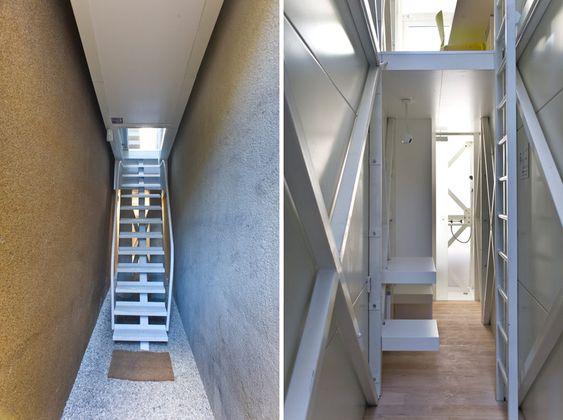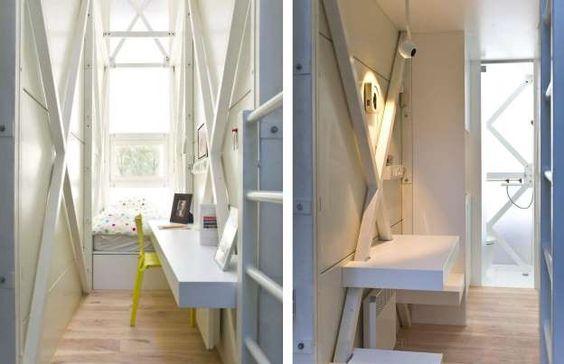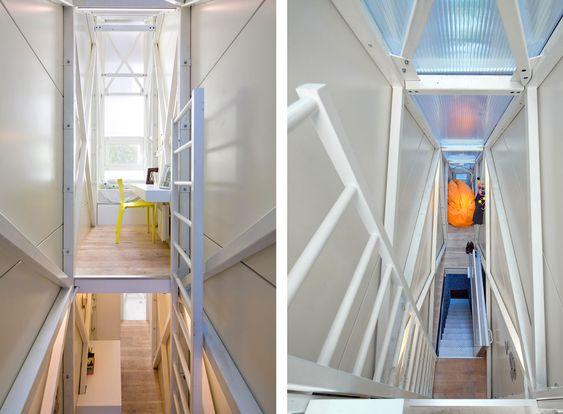



Table of Contents
- Overview of the Keret House
- History and Background
- Architecture and Design Features
- Cultural and Artistic Significance
- Challenges and Construction
- Conclusion
- Faq's
Overview of the Keret House
The Keret House in Warsaw, Poland, is not merely a feat of architecture but a testament to human creativity and adaptability in urban environments. Designed by Polish architect Jakub Szczesny, this narrow structure measures only 1.2 meters at its widest point and tapers to a mere 71 centimeters at its narrowest. Despite its compact size, the house spans four levels, each meticulously designed to maximize functionality within its narrow confines.
Constructed between two existing buildings in Warsaw's Wola district, the Keret House is a response to the challenge of urban space scarcity. It serves as a symbol of innovative architecture, pushing boundaries with its minimalistic design and efficient use of every square meter. The house features a steel frame and wooden interiors, combining modern materials with traditional craftsmanship to create a comfortable living space.
Beyond its physical dimensions, the Keret House has captured global attention for its cultural and artistic significance. Named after Israeli writer Etgar Keret, known for his short stories and commitment to art, the house embodies creativity and artistic expression. It has become a focal point for architectural enthusiasts, drawing visitors from around the world who are intrigued by its unconventional design and the story of its creation.
The Keret House not only challenges conventional notions of space and living but also inspires discussions on urban density, sustainability, and the future of architecture in increasingly crowded cities. Its legacy continues to influence architects and urban planners seeking innovative solutions to housing challenges in urban environments globally.
History and Background
 Keret House Warsaw
Keret House Warsaw
The Keret House, a remarkable architectural achievement situated in Warsaw, Poland, stands as a testament to innovation and creativity in urban living solutions. Designed by Polish architect Jakub Szczesny and completed in 2012, this slender structure was named in honor of Israeli writer Etgar Keret, renowned for his poignant short stories and advocacy for the arts.
Measuring just 1.2 meters at its widest point and narrowing to a mere 71 centimeters, the Keret House is officially recognized as the world's narrowest dwelling. Nestled between two existing buildings in Warsaw's bustling Wola district, it spans four levels interconnected by a ladder-like staircase, ingeniously maximizing every inch of available space.
The house's exterior features a distinctive aluminum facade, while its interiors are crafted from warm, natural materials such as wood, creating a cozy and inviting atmosphere despite its compact dimensions. Inside, the minimalist design incorporates essential living amenities, including a kitchenette, bathroom, and workspace, making it a functional residence despite its size.
Beyond its practicality, the Keret House serves as a symbol of architectural ingenuity and cultural dialogue. It has attracted global attention as an artistic installation and a metaphor for urban challenges, inspiring discussions on housing affordability, sustainability, and the future of urban living. As a living space and a work of art, the Keret House continues to captivate visitors and provoke thought on the intersection of architecture and society.
Architecture and Design Features
 Narrow House Architecture
Narrow House Architecture
The Keret House, renowned as the world's narrowest house, is a testament to innovative urban architecture. Located in Warsaw, Poland, it's just 1.2 meters wide at its widest point, tapering to an astonishingly narrow 71 centimeters. Despite its compact dimensions, the house manages to encompass four functional stories.
Each floor of the Keret House is ingeniously designed to maximize utility within its constrained space. The ground floor serves as an entrance and foyer, leading up to a workspace on the second floor, where the narrow dimensions are creatively utilized for efficiency. The third floor houses a cozy bedroom, complete with essential amenities to ensure comfort despite the limited space. Finally, the top floor features a compact bathroom, showcasing clever design solutions to accommodate essential facilities within such narrow confines.
The architectural concept behind the Keret House is not merely about space efficiency but also about pushing the boundaries of what is possible in urban living. It represents a unique blend of art and functionality, challenging conventional notions of home design and inspiring discussions about how cities can accommodate growing populations with innovative, space-saving solutions.
Cultural and Artistic Significance
 Small Space Living
Small Space Living
The Keret House, an architectural marvel located in Warsaw, Poland, holds significant cultural and artistic value. Designed by Polish architect Jakub Szczesny and completed in 2012, it stands as a symbol of innovation and the creative use of limited urban space. Named after Israeli writer Etgar Keret, the house has become an icon of contemporary architecture, representing a fusion of literature, art, and design.
Culturally, the Keret House serves as a poignant reminder of Warsaw's complex history. Its location in the Wola district, an area heavily impacted by World War II, symbolizes resilience and the enduring human spirit. The house's narrow, vertical structure reflects the constraints and challenges faced by city dwellers in post-war Poland, making it a powerful metaphor for survival and adaptation.
Artistically, the Keret House has inspired numerous discussions and exhibitions about urban living, space utilization, and minimalist design. It has been featured in various art and architecture exhibitions worldwide, showcasing the innovative approach to living in densely populated urban environments. The house's design challenges conventional architectural norms, pushing the boundaries of what is possible in terms of living space.
Moreover, the Keret House has become a cultural landmark, attracting tourists, architects, and artists from around the globe. Its presence in Warsaw has boosted the city's reputation as a hub for cutting-edge architecture and creative expression. The house not only provides a unique living space but also serves as a cultural venue, hosting writers, artists, and thinkers, thereby fostering a vibrant intellectual community.
In conclusion, the Keret House's cultural and artistic significance extends beyond its physical dimensions. It stands as a testament to human creativity, resilience, and the ability to transform even the most constrained spaces into places of beauty and inspiration.
Challenges and Construction
The construction of the Keret House posed several unique challenges due to its exceptionally narrow design and urban location. Situated in a gap between two existing buildings in Warsaw's Wola district, the site presented significant logistical and engineering obstacles. These challenges were met with innovative solutions that showcase the ingenuity of modern architecture.
Challenges:
Limited Space: The primary challenge was the extremely limited width of the site, which measures approximately 1.2 meters at its widest point and narrows down to just 71 centimeters. This required meticulous planning and precision in every aspect of the construction process.
Structural Integrity: Ensuring the structural stability of such a narrow building was crucial. The design had to account for the weight distribution and support necessary to prevent the building from collapsing or causing damage to the adjacent structures.
Utility Installation: Integrating essential utilities such as plumbing, electricity, and ventilation within the narrow confines of the house was a complex task. Specially designed systems and creative routing were necessary to fit these utilities into the limited space.
Access and Mobility: Providing access and ensuring mobility within the house required innovative solutions. The vertical layout necessitated the use of steep ladders and compact stairs, which had to be designed to maximize space while maintaining safety.
Construction:
Site Preparation: The construction began with careful preparation of the narrow site. This included securing the surrounding buildings and ensuring that the site was safe for excavation and building work.
Foundation and Framework: The foundation and structural framework were constructed using lightweight materials to minimize the load on the building. Steel and concrete were used to create a strong yet flexible structure capable of withstanding the narrow dimensions.
Modular Construction: The Keret House utilized modular construction techniques, where pre-fabricated sections were assembled off-site and then transported to the location for installation. This approach minimized on-site construction time and ensured precision in the narrow space.
Innovative Materials: Lightweight and durable materials, such as polycarbonate and aluminum, were used to construct the walls, floors, and roof. These materials provided the necessary strength while keeping the overall weight of the building low.
Efficient Design: The interior design was meticulously planned to maximize the use of available space. Each floor was designed for a specific function, with custom-built furniture and fixtures that fit seamlessly into the narrow layout. The use of light colors and large windows helped create a sense of openness and reduce the feeling of confinement.
Utility Integration: Specially designed plumbing and electrical systems were integrated into the narrow walls and floors. Compact and energy-efficient appliances were used to ensure functionality without compromising on space.
The successful completion of the Keret House stands as a testament to the possibilities of modern architecture and engineering. Overcoming the numerous challenges required a blend of creativity, precision, and innovative thinking, resulting in a unique structure that redefines the concept of urban living in constrained spaces.
Conclusion
The Keret House stands as a testament to human creativity and ingenuity in overcoming architectural challenges. Its compact yet functional design continues to captivate and inspire, demonstrating that even the narrowest spaces can be transformed into livable environments.
explore further
Latest from Did you know?
More from Interactions
Resources
Dwello, for every home buyer, is a way to go from 'I feel' to 'I know', at no extra cost.




